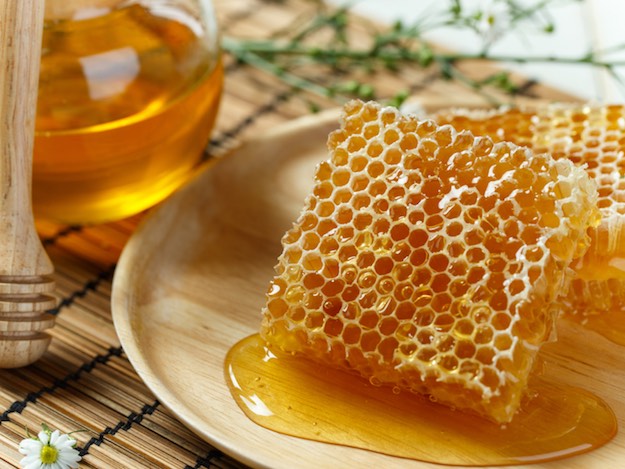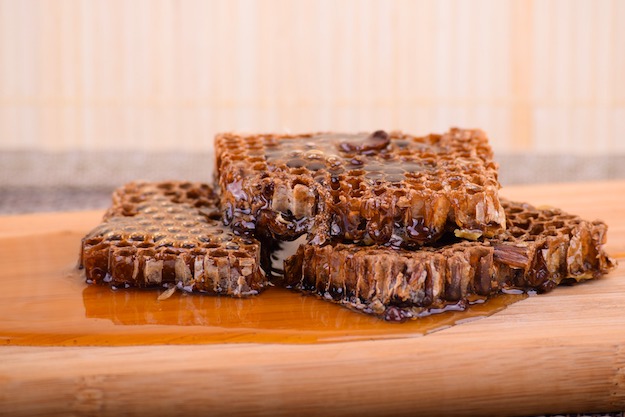Archives
The Benefits of Honey

Honey is one of the most important things you can have in your survival stash. There are so many uses for honey, from first aid to digestion to allergies and even hygiene.
Our friend Gaye Levy from Backdoor Survival has put together your ultimate guide to using honey for survival. Check it out below, and be sure to visit Backdoor Survival for more awesome survival and homesteading tips.
Benefits of Honey | Using Honey for Wellness and Survival
Rich, golden honey. What is not to like? Just the thought of sweet, fragrant honey and honey bees makes me think of happy times. That, coupled with it’s long storage life makes honey a perfect food for the survival pantry. But did you know that honey has a myriad of other uses, including as a therapeutic ointment that promotes healing?
In this article you will learn all about honey, the various types, its use to promote health and wellness, and other ways to use honey that you may not have thought of. But first, a little background about honey and its various forms and types.
Honey is made by bees from their own internal digestion (and regurgitation) of flower nectar. This is stored as a food source in wax honeycombs that are formed within the beehive. With about the same relative sweetness of granulated sugar, honey has a long history of human consumption, going back as far as ancient Egypt. Even back then it was used to sweeten cakes and biscuits.
There is also a long history of honey being used for religious and symbolic purposes. It is reported that jars of honey were found in Pharaoh’s tombs (now that is long term storage for you!) and Alexander the Great was supposedly embalmed in honey. In Jewish tradition, honey is a symbol for the new year, Rosh Hashanah and, at the traditional meal for that holiday, apple slices are dipped in honey and eaten to bring a sweet new year.
Types of Honey
The most recognized form of honey is the sweet, golden liquid that is found on the grocery shelf –often in cute little honey bear shaped squeeze bottles. Honey, however, can be found in various forms:
1. Liquid Honey

Free of visible crystals, liquid honey is extracted from the honey comb by centrifugal force, gravity or straining. Because liquid honey mixes easily into a variety of foods, it’s especially convenient for cooking and baking. Most of the honey produced in the United States is sold in the liquid form.
2. Comb Honey

Comb honey is honey in its original form; that is, honey inside of the honeycomb. Did you know that the beeswax comb is edible?
3. Cut Comb

Cut comb honey is liquid honey that has added chunks of the honey comb in the jar. This is also known as a liquid-cut comb combination.
4. Raw Honey

Raw honey is pure, unheated, unpasteurized and unprocessed. While there is no official U.S. federal definition of raw honey, the National Honey Board defines raw honey as “ honey as it exists in the beehive or as obtained by extraction, settling or straining without adding heat.
5. Naturally Crystallized Honey

Naturally crystallized honey is honey in which part of the glucose content has spontaneously crystallized. It is safe to eat.
6. Whipped (or Creamed) Honey

While all honey will crystallize in time, whipped honey (also known as creamed honey) is brought to market in a crystallized state. The crystallization is controlled so that, at room temperature, the honey can be spread like butter or jelly. In many countries around the world, whipped honey is preferred to the liquid form especially at breakfast time.
7. Honey Mead

Honey mead is actually a wine. It is an alcoholic drink made from honey and water via fermentation with yeast. It may be still, carbonated, or sparkling and it may be dry, semi-sweet, or sweet.
In addition to various forms of honey, there are various types of honey. There is organic honey, local, geographically specific honey, and floral honeys. Furthermore, the various flavors of honey vary based on the nectar source, such as Alfalfa, Clover, Fireweed, Orange Blossom and more.
One very special type of honey is Manuka Honey which is s a product of the bees feeding off the Melaleuca blooms. Melaleuca probably sounds familiar because in its essential oil form, it is also known as tea tree oil! Manuka honey leads the pack when it comes to therapeutic use and is known as the Queen of medicinal honeys”.
The Use of Honey in Medicine
When it comes to therapeutic use, honey has been used for centuries to promote healing. Ancient Egyptians, Assyrians, Chinese, Greeks and Romans employed honey for wounds and diseases of the intestine. On the other hand, up until very recently, modern medicine has shunned honey for lack of so-called documentary evidence. That is now changing as more and more members of the medical community embrace the antibacterial, anti-microbial, and wound healing properties.
By far, the most common main stream medical use of honey is to treat sore throats. Honey has been used in this manner for centuries and to this day it is used as a treatment for sore throats and coughs. Another use that is becoming more common is the treatment of wounds.
According to Amy Alton, co-author of The Survival Medicine Handbook and an authority on survival medicine atwww.doomandbloom.net has this to say:
“Within wounds, honey not only destroys bacterial infections, it creates a moist healing environment that allows skin cells to regrow naturally. This helps prevent raised scarring. Honey both prevents and kills bacterial infections. It has an acidic pH that is inhospitable for bacteria. It also has an osmotic effect which kills by drawing out fluid from the bacteria. Several studies have shown honey heals wounds better and faster, with a dramatic decrease in infection rates, especially in burn injuries.
Apply to cuts, scrapes, burns of any depth if medical help is not available, rashes, or any open skin injury, after good wound cleaning.
In the event of a severe second degree burn or any third degree burn, immediate medical help should be sought. In the event this help is not available, using RAW honey would be the best choice for healing and prevention of infection. Do not rinse off the honey, just add more at least once daily and cover with plastic wrap or a clean linen or cotton wrap to hold the honey in place. Severe burn patients are at a serious risk for many problems and need to be monitored by the best medical personnel possible.”
Recently the antiseptic and antibacterial properties of honey been studied and chemically explained and even the prestigious Mayo Clinic has recognized various medical uses of honey.
There is just one caution: Honey sometimes contains dormant spores of a type of botulism, which can be dangerous to an infants intestinal tract. For that reason, children under one year of age should not be given honey in any form.
20 Uses of Honey for Wellness and Survival
If the only time you pull out the honey jar is to sweeten your food, you are in for a surprise. There are literally dozens of uses for honey that you are missing. Here is a short list of alternative uses for honey.
Treat sore, scratchy throat: Mix honey with lemon juice to create a throat-relieving serum. Repeat as often as needed until symptoms are reduced, if not gone.
Cough Syrup: Use as a cough suppressant instead of using a commercial cough syrup which is full of sugar and unwanted chemicals. Note: Do not, under any circumstances, use on children under the age of one.
Heal Wounds: Honey, and Manuka Honey especially, is known to heal wounds by killing bacterial and fighting infections. Apply liberally then cover with a dressing. For an interesting scientific article on using honey to treat wounds, read Patients Should Ask Surgeons About Using Honey To Heal Wounds.
Reduce/Relieve Acid Reflux: Consume 1 tablespoon a day to relieve to acid reflux.
Topical Antiseptic: The hydrogen peroxide released by honey makes it the perfect topical antiseptic for cuts and scrapes. In addition, due to its viscous consistency, it also prevents wounds and scabs from sticking to the dressing or bandage.
Remove Parasites – Combine equal parts honey, vinegar and water. Then drink. The combination of these three ingredients is supposedly the perfect parasite killer.
Boost Immunity: The phytonutrients in raw honey have antibacterial and antiviral properties that may help boost the immune system and fight sickness. If you’re feeling a little under the weather, try combining 1 tablespoon of honey and 2 teaspoons of lemon juice in a 1/2 cup of hot, but not boiling, water.
Sleep Aid: Honey is known to facilitate the action of tryptophan, which helps make people sleepy.

Allergy Relief: The daily consumption of locally harvested honey is said to to reduce any allergies you have to localized plant pollens.
Energy Booster: Mix honey with some water then drink the solution. Honey’s glucose content will be absorbed by the brain and in the bloodstream, reducing fatigue in the process.

Improve Blood Flow: Honey, being rich in glucose, is known to improve the blood flow through the fortification of blood’s formation. Glucose provides energy in the bloodstream, which is distributed throughout the body. As a result, the blood produced has the proper consistency, flowing smoothly through the blood vessels. Glucose is believed to prevent capillary damage due to its ability to improve your blood flow.
Burn Treatment: Apply honey as a dressing to burns. The hydrogen peroxide released by the honey cleans the wound and soothes the inflammation. Burn marks will heal quickly and with less pain.
Antibacterial Solution: Given its acidic pH balance and viscous base, bacteria and germs won’t survive when covered in honey. The microorganisms will be trapped in the sticky acidic base, which is too abrasive for their exteriors, killing them off eventually.
Calms Anxiety and Promotes Relaxation: Anytime, but especially while in survival mode, you need to be clear headed and calm. Honey’s nutrients produce a calming effect, especially when taken in significant amounts.
Aids Digestion: Mix honey and apple cider vinegar in equal proportion then dilute with water. This natural drink aids digestion.
Substitute Honey for Sugar in Baking: For every cup of sugar a recipe calls for, replace it with 3/4 cup of honey. For best results, add 1/4 teaspoon of baking soda and reduce another liquid in your recipe by 1/4 cup. Also, reduce the oven temperature by 25 degrees.
Hair Conditioner: Add a teaspoon of honey to your regular shampoo or conditioner. You can also combine it with olive oil for a deeper conditioning. Let it soak for 20 minutes with your hair wrapped in a towel before shampooing as usual.
Skin Moisturizer: Put honey on your skin and leave it there 15 minutes then rinse off. Your skin will be soft and nicely moisturized.

Zap Acne: Apply a a small amount of honey directly on acne with a cotton swab or finger. Wait five minutes and then rinse with warm water.
Food Preservative: Honey is known food preservative, replacing chemical additives and refined sugars in many commercial products. When used to replace sugar in homemade bread and baked goods, the result will be a moist product that stays fresh longer and will be less likely to mold.
Storing Honey
Storing honey is a easy in that there are just a few simple guidelines that will insure it’s long term viability and pleasing color. The main thing you want to do is store honey at room temperature. Extreme high or low temperatures should be avoided although neither will affect it’s quality.
About the worst thing than can happen to honey is that it will crystallize. This is a normal part of the honey aging process whereby the liquid in honey becomes solid. Storing honey is the refrigerator hastens this process so don’t do it. Easy as that.
Regardless of how careful you are, in a long term storage situation, honey will crystallize. When that happens, simply place the honey jar in warm water and stir until the crystals dissolve. Just be careful not to overdo it since too much heat will darken the honey even more and may possible scorch and burn the honey.
Cooking With Honey
Although it is optimal to use recipes developed for honey, it can easily be substituted for sugar by following just a few simple guidelines. Begin by substituting honey for up to half of the sugar called for in the recipe. If that works out well, you can add more next time, gradually increasing the substitution as long as you are satisfied with the results.
Here are some specific tips for using honey in baked goods:
- Use 75% liquid honey for each cup of sugar called for in the recipe
- As a rule of thumb, reduce the liquid in the recipe by 1/4 cup for each cup of honey used
- Add about 1/2 teaspoon baking soda for each cup of honey used
- To prevent over-browning, reduce oven temperature by 25 degrees to prevent over-browning
Worried about a sticky mess when cooking with honey? For easy measuring and clean-up, coat your measuring cup or spoon with cooking spray before adding honey.
Here is one of my favorite uses of honey – homemade honey butter!
Honey Butter
1/2 cup butter (fresh, canned or made from butter powder)
1/4 teaspoon vanilla extract or 1/16 vanilla powder
1/2 cup honey
Mix all ingredients together until creamy. Use to serve on any hot bread, biscuits or cornbread. Yummy.
Nutritional Profile of Honey
Honey is composed primarily of carbohydrates (natural sugars) and water, as well as trace enzymes, minerals, vitamins, and amino acids. Providing 17 grams of carbohydrates and 64 calories per tablespoon, honey is an all-natural sweetener without any added ingredients.
Honey also contains a variety of flavonoids and phenolic acids, which act as antioxidants, scavenging and eliminating free radicals. Generally, darker honeys have higher antioxidant content than lighter honeys.
The Final Word

It would be impossible to describe all of the benefits of honey in a single article. Manuka honey, in of itself, warrants a discussion of the progress the medical community has made in documenting its therapeutic and healing properties. The more I learn, the more I am convinced that Manuka honey has a place in the emergency survival kit.
Honey blends well with many foods, is delicious to eat, and has an shelf life that does not expire. Along those lines, for definitive information on the shelf-life of honey, read The Science Behind Honey’s Eternal Shelf Life.
In closing, I want to let you know that I a personally enjoy a bit of organic,100% raw honey when ever I indulge in a bowl of Greek yogurt and bananas. Simply delicious! And yes, as I think of honey bees, I do indeed put a big smile in my face!
To learn more about other surprising uses of items, check out these articles:
11 Survival Uses for a Tin Can
Surprising Uses for Household Items
Enjoy your next adventure through common sense and thoughtful preparation!
Gaye
-

 Do It Yourself7 months ago
Do It Yourself7 months agoParacord Projects | 36 Cool Paracord Ideas For Your Paracord Survival Projects
-

 Do It Yourself9 months ago
Do It Yourself9 months agoHow To Make Paracord Survival Bracelets | DIY Survival Prepping
-

 Do It Yourself9 months ago
Do It Yourself9 months ago21 Home Remedies For Toothache Pain Relief
-

 Do It Yourself10 months ago
Do It Yourself10 months agoSurvival DIY: How To Melt Aluminum Cans For Casting
-

 Exports8 months ago
Exports8 months agoAre Switchblades Legal? Knife Laws By State








Pingback: 20 Ways to Use Honey for Wellness and Survival | Patriot Powered News
Pingback: The Many Survival Uses of Honey | Patriot Powered News
Pingback: The Many Survival Uses of Honey » Survival Gear & Food Storage
G C
June 12, 2015 at 9:50 AM
I use honey for all of my sweetners
WBM INTERNATIONAL
June 17, 2015 at 5:11 AM
http://www.salt84.com/salt-lamps-cooking-plates-natural-solutions
Willie R. Gillis
June 17, 2015 at 5:22 AM
<-+++++++ My buddy's sister makes $79 an hour on the internet . She has been unemployed for seven months but last month her pay check was $19423 just working on the internet for a few hours. Visit Website. She actually started four months ago and pretty much immediately began to make more than $715… Every week. Find out here n0w –
>/
Pingback: 8 Herbal Teas and Their Medical Benefits | Survival Life
Pingback: Asthma Symptoms: 9 Natural Ways To Help You Breathe Easy
Pingback: Home Remedies For Cold And Flu | 25 Surprisingly Simple Natural Relief
Pingback: Home Remedies For Cold And Flu | 25 Surprisingly Simple Natural Relief – Ultimate Survival Alerts
Pingback: Medicinal Plants You Need To Make Natural Home Remedies
Pingback: Medicinal Plants You Need To Make Natural Home Remedies – Viral News And Videos Today's